Bird watching and photography are both great passions of mine and I never get tired of either one. In fact, I find myself constantly driven to go out more and more each week in search of new, unseen birds to watch and to photograph the interesting scenes in nature I may come across during these excursions. If you were to ask me what my favorite spots are for these activities, without question, I would have to put the Bear River Migratory Bird Refuge at the top of the list.
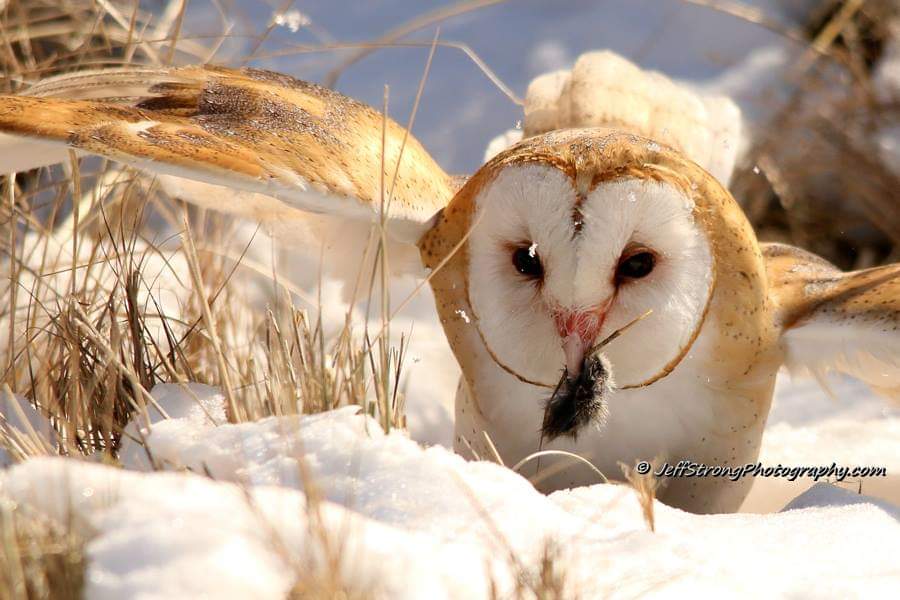
But why do I regard the refuge so highly for bird watching and photography when there are so many other places I could go to instead? Simply put, I do visit other places from time to time but, in all honesty, I love the variety of birds I find throughout the year on the refuge and I really enjoy the solitude that comes from such a remote location.
The U.S. Fish and Wildlife Service, the managing agency for the refuge, has said over 270 species of birds have been recorded on and around the refuge area so you can see why I like this particular spot for its variety of birds.
So let me tell you, no, better yet, let me show you what I mean about why I like this place so much from a few photographs taken on my most recent trip to the Bear River Bird Refuge.
A couple days ago, after waking up and being greeted by a sunny morning, the kind most of us nature photographers dream about, I decided to take a drive around the auto tour route to see what winter birds I could find and photograph.
I didn’t come home with a lot of great images, however, due to my camera malfunctioning and losing its focusing ability for some reason but, even with those technical frustrations every photographer eventually has to face, I thoroughly enjoyed the couple of hours I spent driving the refuge auto loop.
The images didn’t turn out as sharp and clear as I had hoped as it looks like I need to replace my camera and/or lens but they are good enough to post here to help illustrate my point about why I love the bird refuge.
Where is the best place to find birds on the refuge during the winter?
Winter can be one of the trickier times of the year to consistently find birds to watch and photograph and there are some days on the refuge I do have very little success during winter but I have also learned to watch in areas I usually overlook during summer to mitigate these slower times of the year.

Driving Forest street from the refuge visitors center to the auto tour route is one area I sometimes overlook during summer but wintertime can be one of the best times on Forest street to find birds. The 12-mile paved road can be a good place to see winter birds such as prairie falcons hunting the short grasses and open fields. This year I have seen several prairie falcons on my drive down forest street as well as countless american kestrels hunting the roadsides for voles.
Over the years, I have seen bald eagles, rough-legged hawks, peregrine falcons, merlin falcons, prairie falcons, barn owls, short-eared owls, and a couple great horned owls while driving between the refuge visitors center and the auto tour route during winter.
Another area that is usually more productive during winter for bird watching is the north and south portions of the auto tour route. Both of these areas have something in common, moving water. During our coldest stretches of winter, open water can be hard to find and if you find open winter you can usually find birds.
The refuge canals and water control structures are oftentimes the last parts of the refuge to freeze and being such, birds will tend to be found along these areas. Both the north and south portions of the auto tour route have areas of moving water flowing in canals and through the concrete structures and they are oftentimes my go-to spots on the refuge when all else is frozen.
Great blue herons, gulls and a variety of ducks can often be found hanging around these pockets of moving water.
Rough-legged Hawk on the Side of the Road
The first bird I stopped to photograph was a rough-legged hawk sitting on the shoulder of the gravely auto tour route, quietly perched on a small mound of ice. Lately, these arctic raptors have been hard for me to get close enough to photograph but today this one, and this one only, sat contently as I watched and photographed it for about 5 minutes before the raptor took to the air to hunt for rodents.
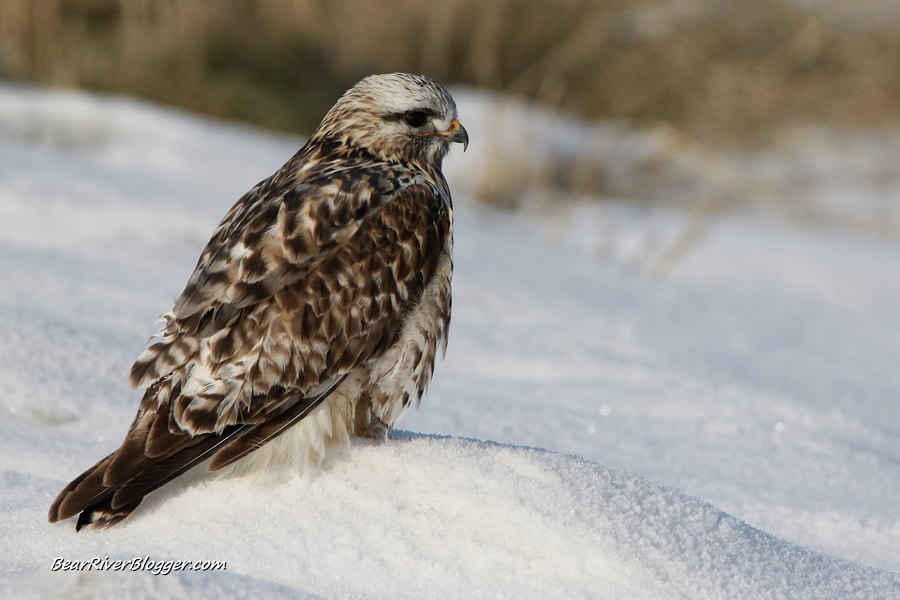
Rough-legged hawks are a fascinating winter bird on the refuge, for sure. At least in my mind they are, that is. This species of hawk spends its summer months breeding in the far northern reaches of the arctic tundra and migrates southward to more moderate winter climates and regions, including northern Utah and the bird refuge.
These raptors only spend a few short months on the refuge, hunting rodents, and small birds, before they migrate thousands of miles north back to the arctic region where they nest and raise another round of hawks.
They usually show up around December and spend the coldest, harshest months of the year living on the refuge, which, at times, can be extremely frigid. Temperatures can dip below zero degrees Fahrenheit during the night and only go up a few degrees during the day when we get arctic air from the north settling in during some of our harshest winters here in Utah.
But despite these almost annual encounters with some of mother nature’s most brutal winter conditions, the rough-legged hawk seems to not be affected by even our worst winter seasons.
As I sat and watched this rough-legged hawk, I noticed something about its eye. The brown mottled raptor briefly showed its nictitating membrane, a third eyelid that helps protect and moisten the bird’s eye. The membrane is clear which still allows the bird to still see while affording its eyes an additional amount of protection.
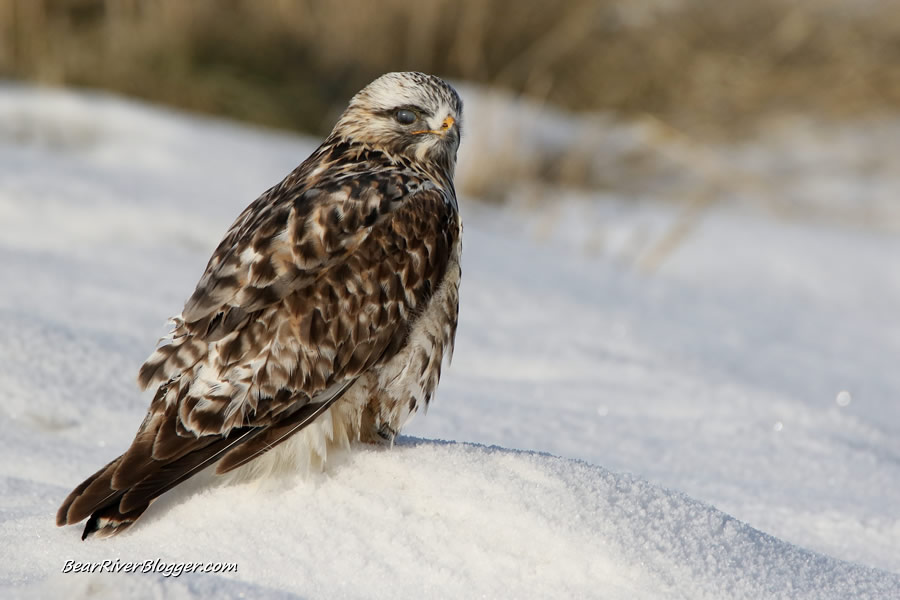
Here is a look at the eye without the membrane shown. I don’t know how often or how long the nictitating membrane is used but this particular bird seemed to have it out for only a brief period of time, maybe just a few seconds or so from what I could tell from my vantage point.
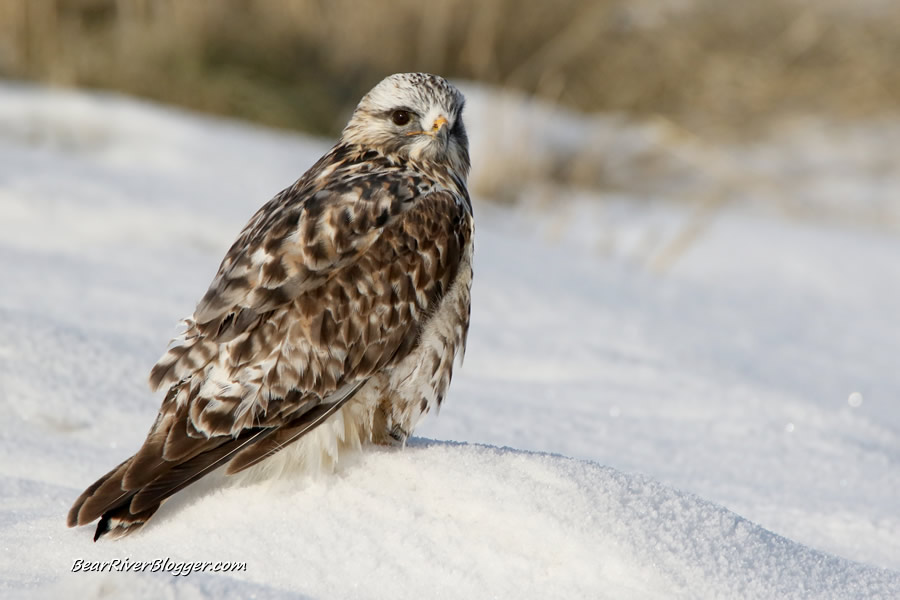
Although rough-legged hawks are only on the refuge for a few short months, they offer an interesting and unique experience for bird watchers looking to add an arctic breeding bird to their birding life list. During this time of year, I literally see them each day I am on the refuge.
Some days, I have counted over 24 sightings of rough-legged hawks on Forest Street and the auto tour route. Other days, I only see three or four so they seem to move around a little bit, at least from what I can tell from my casual observations.
Winter Great Blue Herons on the Refuge
When it comes to winter bird photography, nothing gets my juices flowing like the great blue heron. Personally, I find great blue herons very interesting birds because they can stand for long periods of time without moving a muscle while waiting to snatch a fish or other creature from the water. This is even more fascinating to me when winter comes along and I get to observe and photograph these birds standing over a small ice hole doing the same.
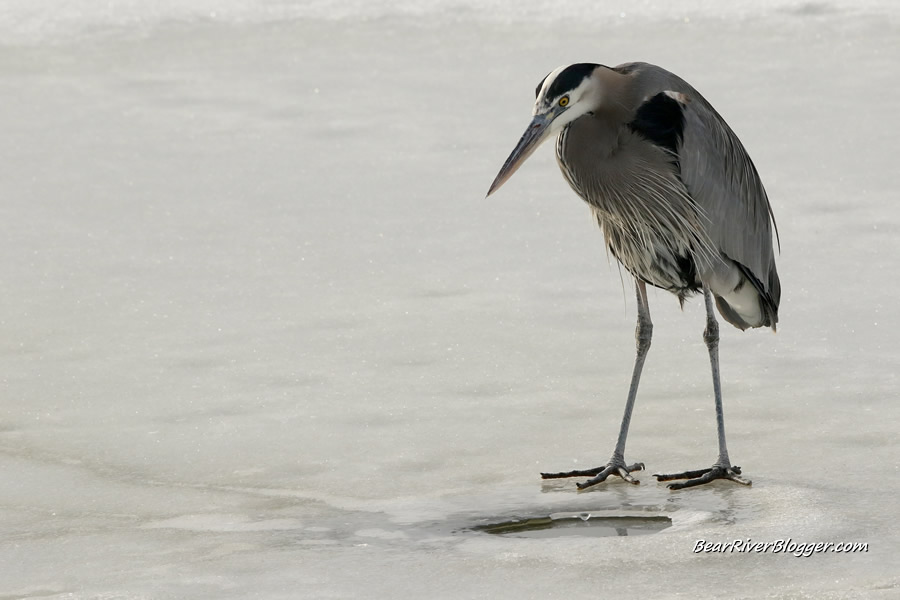
I will admit, without any reservation what so ever, I am not a fan of winter at all but I would be lying if I also said I don’t get very excited when I get to watch and photograph these large birds standing on the ice, hovering over an ice hole in wait for an unsuspecting fish to swim by. It is such an interesting scene to observe and photograph.
I have another blog post I will be working on soon pertaining to the great blue heron hunting during the wintertime with some amazing images I took during a couple of times the heron tried to catch a fish through the ice. Watching them in such conditions, I learned of an interesting behavior these birds can display at times during the winter months when food is scarce and competition for what food is available is very high.
More about the great blue heron ice fishing in an upcoming post so stay tuned.
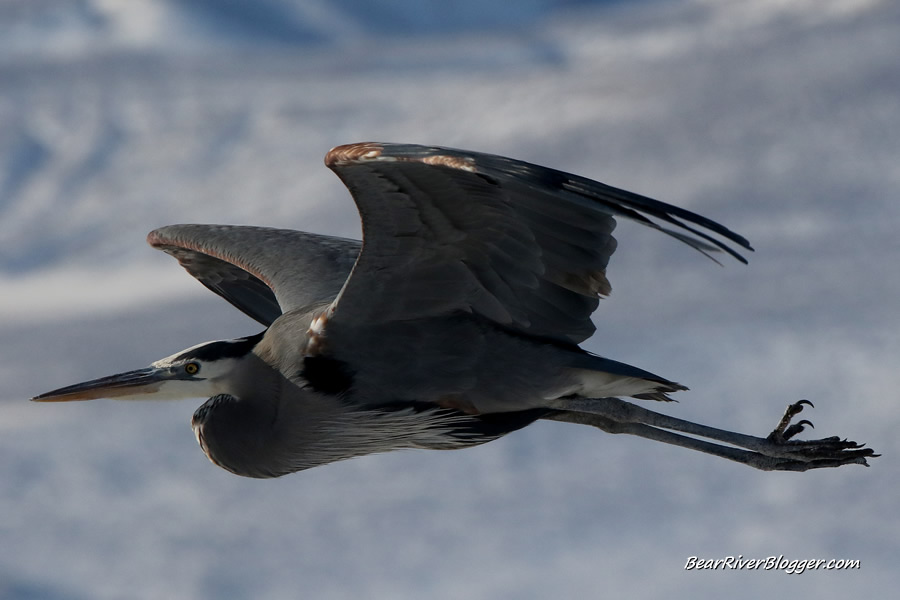
Tundra Swans Wintering on the Refuge
As I was getting to the end of the auto tour route, I stopped to try and capture one last image for the day of a great blue heron on a small pocket of open water. My effort was to no avail, however, as the great blue heron flew off just as my truck came to a stop. But just after I turned off the engine I heard a sweet, almost soothing sound, one I have been longing to hear since early December.
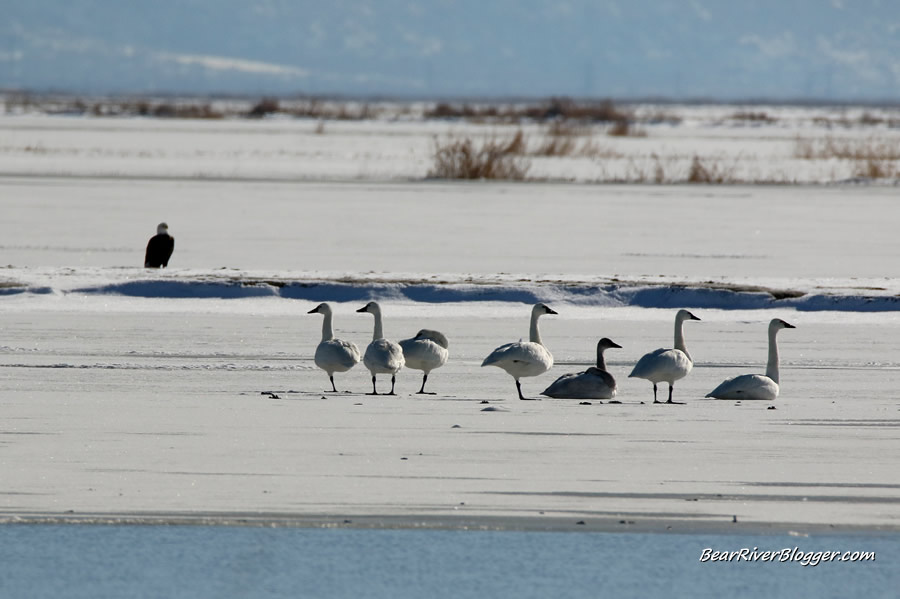
If the above image or heading didn’t give it away, I came across a small band of tundra swans on the last leg of the auto tour route. These large white members of the waterfowl family come to and, for a period of time, stopover on the Bear River Migratory Bird Refuge twice per year as they migrate between their breeding grounds in far northern Alaska and their wintering grounds in California.
This time of year seeing the tundra swan is a rarity on the refuge but it isn’t completely unheard of to see a few toughing it out on the frozen marsh for the winter. I counted about 200 or so tundra swans in this small band of birds.
A bald eagle sat just a few short yards behind one of the groups of swans but for some reason, they showed no interest or fear for the eagle but was more interested in what I was doing.

Usually, about mid-February or so, tundra swans start showing up on the refuge again as spring migration inches its way forth. The last few years, however, I have seen small bands of swans sticking around the refuge all winter so it really isn’t a big surprise I came across these swans just off of the auto tour route the other day.
I am now getting excited for March because of this unexpected but very welcomed surprise. March is when the vast majority of swans start showing up on the refuge and it is when I spend most of my time trying to photograph these most beautiful birds for the few short weeks they are here in Utah.
You see, no matter what time of year it is, I am always finding birds to watch and photograph on the Bear River Migratory Bird Refuge. Arguably, spring and summer are the most active times with the most variety of birds but for me, it’s not always about the number of birds I see and photograph but more so about the experiences I have and how I can enjoy nature as it was meant to be, individually and in a bit of solitude.
Feel free to subscribe to my blog about nature on and off of the Bear River Migratory Bird Refuge. It is my life’s passion to photograph and share my experiences of all the places in nature I am fortunate to visit and photograph for others to see.


